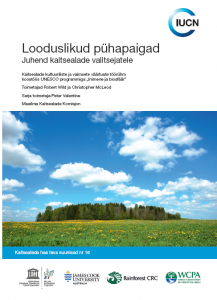
En Estonia, en torno a 2500 sagrados tradicionais sitios naturais, cubrindo grandes áreas de terra son coñecidos por conteren significativas espiritual, cultural e natural valores do patrimonio. Investigación e documentación espérase para revelar unha rede de ata 7000 sagrados sitios naturais no país só.
 Co apoio do Ministerio de Medio Ambiente de Estonia, a ONG “Casa de Estonia Taara e relixións nativas (A Cámara de Non Cristiáns e Maausulis de Maavalla)” traduciu a UNESCO IUCN “Sacred Sitios Natural, Directrices para Xerentes de Área Protexida” en estoniano. Maavalla Koda en colaboración coas institucións ambientais estatais agora é capaz de usar as Directrices para mellorar o recoñecemento, protección e promoción da sagrada sitios naturais. As Directrices contribuirán á aplicación do ministerio do plan de cultura de conservación nacional de sitios naturais sagrados e será apoiada por formación de funcionarios estatais e gardiáns do sagrado sitios naturais. Para iso un grupo de apoio foi formada por 17 membros do parlamento de Estonia, na primavera de 2011.
Co apoio do Ministerio de Medio Ambiente de Estonia, a ONG “Casa de Estonia Taara e relixións nativas (A Cámara de Non Cristiáns e Maausulis de Maavalla)” traduciu a UNESCO IUCN “Sacred Sitios Natural, Directrices para Xerentes de Área Protexida” en estoniano. Maavalla Koda en colaboración coas institucións ambientais estatais agora é capaz de usar as Directrices para mellorar o recoñecemento, protección e promoción da sagrada sitios naturais. As Directrices contribuirán á aplicación do ministerio do plan de cultura de conservación nacional de sitios naturais sagrados e será apoiada por formación de funcionarios estatais e gardiáns do sagrado sitios naturais. Para iso un grupo de apoio foi formada por 17 membros do parlamento de Estonia, na primavera de 2011.
As Directrices son o número 16 na Comisión Mundial de Áreas Protexidas’ Serie Mellores Prácticas (vista aquí) e foron desenvolvidos polo grupo de especialista en valores culturais e espirituais de áreas protexidas. "As orientacións están en alta demanda. Dende o seu lanzamento en World Conservation Congress en IUCN 2008 eles foron traducidos do inglés para ruso, español e estoniano mentres se están elaborando versións en francés e xaponés", di o Sr. Robert Salvaxe, coautor das Directrices e presidente do CSVPA. Co apoio da WCPA e do Christensen Fund, as Directrices están a ser traducidas actualmente, probado, revisado e ampliado con novos casos prácticos pola Iniciativa de Sitios Naturais Sagrados.
O caso de conservación de sitios naturais sagrados en Estonia é un de aproximadamente 35 casos que forman parte da Delos Iniciativa, unha iniciativa que traballa para mellorar a conservación dos lugares naturais asustados nos países tecnoloxicamente desenvolvidos. “Durante o terceiro obradoiro da Iniciativa Delos en Inari en 2010 Aprendín sobre os esforzos do Grupo de Especialistas en Valores Culturais e Espirituais da UICN para protexer e conservar sitios naturais sagrados en todo o mundo. Decateime de que as Directrices da UNESCO da UICN serían unha ferramenta moi eficaz para conservar os lugares naturais sagrados de Estonia” di o Sr. Atho Kaasik o ancián de Maavalla Koda.
Aínda que a superficie total de Estonia non é máis que 47.000 km2, no seu territorio atópanse varias áreas lingüísticas e culturais diferentes, e de aí que tamén existan variacións rexionais nos tipos e nomes dos sitios naturais sagrados. Por exemplo, as pedras e as árbores utilizadas para a curación son habituais na parte occidental do país. Lugares comunais que levan o nome de estes (souto sagrado) están espallados polo norte e o oeste do país. A tradición das árbores cruzadas asociada aos costumes funerarios só se conserva no sueste de Estonia.
Desde unha perspectiva máis ampla, Os lugares naturais sagrados de Estonia forman parte das tradicións dos lugares sagrados ugro-feno. Por razóns históricas, relixión tradicional estonia maausk evolucionou en gran medida como familiar, persoal e confidencial. Os lugares naturais sagrados utilízanse para rezar, curación, pedir a bendición para o propio matrimonio, darlle un nome ao seu fillo, asesoramento, facendo ofrendas e realizando diversos rituais, especialmente nos días santos do calendario popular. Hoxe, os sitios naturais sagrados están en perigo de extinción principalmente pola falta de regulación legal e de concienciación sobre os sitios naturais sagrados..






